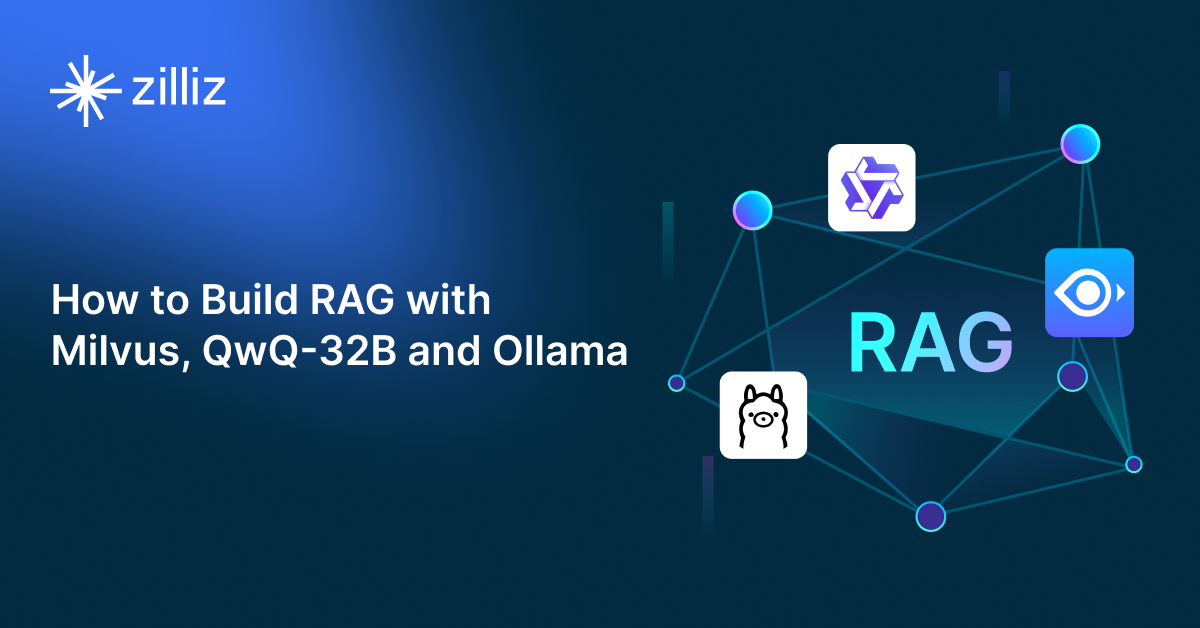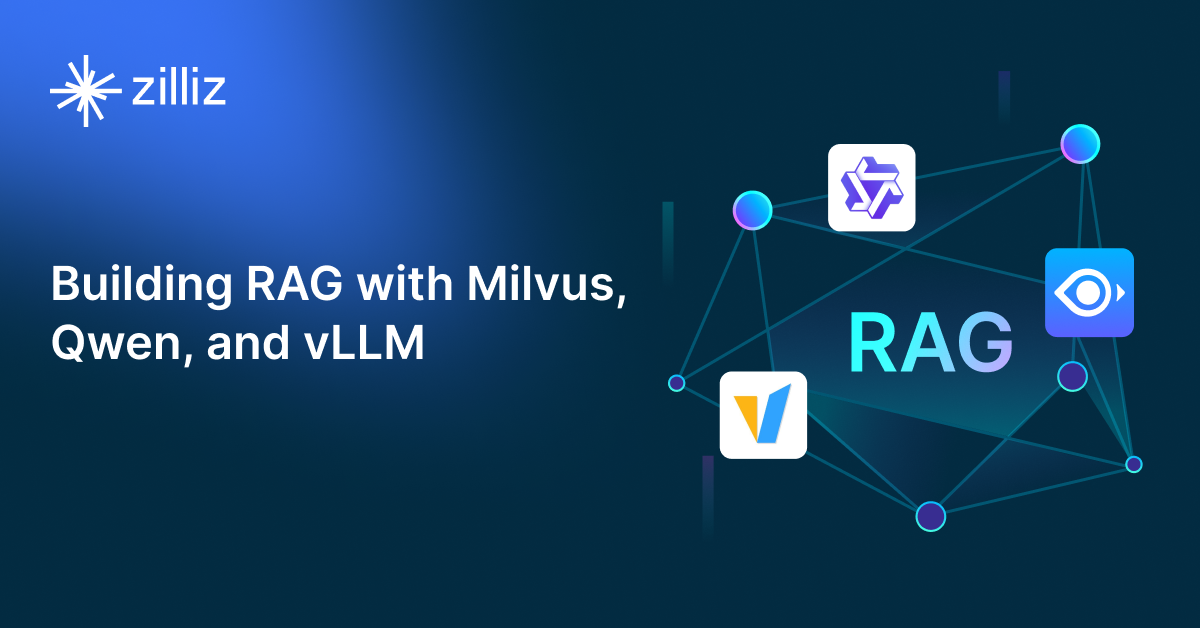Build RAG Chatbot with LangChain, Zilliz Cloud, AWS Bedrock Claude 3 Haiku, and Ollama nomic-embed-text
Introduction to RAG
Retrieval-Augmented Generation (RAG) is a game-changer for GenAI applications, especially in conversational AI. It combines the power of pre-trained large language models (LLMs) like OpenAI’s GPT with external knowledge sources stored in vector databases such as Milvus and Zilliz Cloud, allowing for more accurate, contextually relevant, and up-to-date response generation. A RAG pipeline usually consists of four basic components: a vector database, an embedding model, an LLM, and a framework.
Key Components We'll Use for This RAG Chatbot
This tutorial shows you how to build a simple RAG chatbot in Python using the following components:
- LangChain: An open-source framework that helps you orchestrate the interaction between LLMs, vector stores, embedding models, etc, making it easier to integrate a RAG pipeline.
- Zilliz Cloud: a fully managed vector database-as-a-service platform built on top of the open-source Milvus, designed to handle high-performance vector data processing at scale. It enables organizations to efficiently store, search, and analyze large volumes of unstructured data, such as text, images, or audio, by leveraging advanced vector search technology. It offers a free tier supporting up to 1 million vectors.
- AWS Bedrock Claude 3 Haiku: This model harnesses the power of Claude 3 within AWS's Bedrock service, facilitating scalable AI solutions. It excels in natural language understanding and generation tasks, making it ideal for customer support, content creation, and conversational agents. Its integration with cloud infrastructure ensures flexibility and ease of deployment for enterprises.
- Ollama nomic-embed-text: This model specializes in generating high-quality text embeddings, designed to enhance semantic understanding in various NLP tasks. Its strengths lie in contextual representation and scalability, making it suitable for applications like semantic search, recommendation systems, and clustering. Ideal for developers looking to integrate profound text analysis into their projects.
By the end of this tutorial, you’ll have a functional chatbot capable of answering questions based on a custom knowledge base.
Note: Since we may use proprietary models in our tutorials, make sure you have the required API key beforehand.
Step 1: Install and Set Up LangChain
%pip install --quiet --upgrade langchain-text-splitters langchain-community langgraph
Step 2: Install and Set Up AWS Bedrock Claude 3 Haiku
pip install -qU "langchain[aws]"
# Ensure your AWS credentials are configured
from langchain.chat_models import init_chat_model
llm = init_chat_model("anthropic.claude-3-haiku-20240307-v1:0", model_provider="bedrock_converse")
Step 3: Install and Set Up Ollama nomic-embed-text
pip install -qU langchain-ollama
from langchain_ollama import OllamaEmbeddings
embeddings = OllamaEmbeddings(model="nomic-embed-text")
Step 4: Install and Set Up Zilliz Cloud
pip install -qU langchain-milvus
from langchain_milvus import Zilliz
vector_store = Zilliz(
embedding_function=embeddings,
connection_args={
"uri": ZILLIZ_CLOUD_URI,
"token": ZILLIZ_CLOUD_TOKEN,
},
)
Step 5: Build a RAG Chatbot
Now that you’ve set up all components, let’s start to build a simple chatbot. We’ll use the Milvus introduction doc as a private knowledge base. You can replace it with your own dataset to customize your RAG chatbot.
import bs4
from langchain import hub
from langchain_community.document_loaders import WebBaseLoader
from langchain_core.documents import Document
from langchain_text_splitters import RecursiveCharacterTextSplitter
from langgraph.graph import START, StateGraph
from typing_extensions import List, TypedDict
# Load and chunk contents of the blog
loader = WebBaseLoader(
web_paths=("https://milvus.io/docs/overview.md",),
bs_kwargs=dict(
parse_only=bs4.SoupStrainer(
class_=("doc-style doc-post-content")
)
),
)
docs = loader.load()
text_splitter = RecursiveCharacterTextSplitter(chunk_size=1000, chunk_overlap=200)
all_splits = text_splitter.split_documents(docs)
# Index chunks
_ = vector_store.add_documents(documents=all_splits)
# Define prompt for question-answering
prompt = hub.pull("rlm/rag-prompt")
# Define state for application
class State(TypedDict):
question: str
context: List[Document]
answer: str
# Define application steps
def retrieve(state: State):
retrieved_docs = vector_store.similarity_search(state["question"])
return {"context": retrieved_docs}
def generate(state: State):
docs_content = "\n\n".join(doc.page_content for doc in state["context"])
messages = prompt.invoke({"question": state["question"], "context": docs_content})
response = llm.invoke(messages)
return {"answer": response.content}
# Compile application and test
graph_builder = StateGraph(State).add_sequence([retrieve, generate])
graph_builder.add_edge(START, "retrieve")
graph = graph_builder.compile()
Test the Chatbot
Yeah! You've built your own chatbot. Let's ask the chatbot a question.
response = graph.invoke({"question": "What data types does Milvus support?"})
print(response["answer"])
Example Output
Milvus supports various data types including sparse vectors, binary vectors, JSON, and arrays. Additionally, it handles common numerical and character types, making it versatile for different data modeling needs. This allows users to manage unstructured or multi-modal data efficiently.
Optimization Tips
As you build your RAG system, optimization is key to ensuring peak performance and efficiency. While setting up the components is an essential first step, fine-tuning each one will help you create a solution that works even better and scales seamlessly. In this section, we’ll share some practical tips for optimizing all these components, giving you the edge to build smarter, faster, and more responsive RAG applications.
LangChain optimization tips
To optimize LangChain, focus on minimizing redundant operations in your workflow by structuring your chains and agents efficiently. Use caching to avoid repeated computations, speeding up your system, and experiment with modular design to ensure that components like models or databases can be easily swapped out. This will provide both flexibility and efficiency, allowing you to quickly scale your system without unnecessary delays or complications.
Zilliz Cloud optimization tips
Optimizing Zilliz Cloud for a RAG system involves efficient index selection, query tuning, and resource management. Use Hierarchical Navigable Small World (HNSW) indexing for high-speed, approximate nearest neighbor search while balancing recall and efficiency. Fine-tune ef_construction and M parameters based on your dataset size and query workload to optimize search accuracy and latency. Enable dynamic scaling to handle fluctuating workloads efficiently, ensuring smooth performance under varying query loads. Implement data partitioning to improve retrieval speed by grouping related data, reducing unnecessary comparisons. Regularly update and optimize embeddings to keep results relevant, particularly when dealing with evolving datasets. Use hybrid search techniques, such as combining vector and keyword search, to improve response quality. Monitor system metrics in Zilliz Cloud’s dashboard and adjust configurations accordingly to maintain low-latency, high-throughput performance.
AWS Bedrock Claude 3 Haiku optimization tips
Claude 3 Haiku on AWS Bedrock is designed for speed and efficiency, making it ideal for real-time RAG applications. Optimize retrieval by prioritizing high-precision embeddings and filtering out low-relevance documents before passing them to the model. Keep prompts structured with clear formatting to help the model focus on the most critical context. Use temperature settings between 0.1 and 0.3 for factual accuracy and adjust top-p to balance diversity. For latency-sensitive applications, leverage AWS Bedrock’s scaling capabilities to ensure smooth performance under heavy loads. Implement caching for frequently accessed queries to reduce API calls and improve response times. If used in a multi-model setup, reserve Haiku for fast preliminary filtering or summarization before escalating complex queries to larger models.
Ollama nomic-embed-text optimization tips
Ollama nomic-embed-text is designed for robust text embedding generation, making it essential to optimize how embeddings are stored and queried in a RAG pipeline. Preprocess input text by stripping unnecessary metadata and normalizing case to maintain consistency. Choose an optimized vector indexing strategy, such as IVF-PQ for balanced speed and accuracy, depending on dataset size. Use approximate nearest neighbor search to accelerate retrieval while maintaining a high recall rate. Cache commonly accessed embeddings to avoid redundant computations. If embeddings are used for long-term retrieval tasks, periodically refresh and retrain on new data to prevent model drift. Optimize database queries to quickly retrieve relevant embeddings and minimize I/O bottlenecks.
By implementing these tips across your components, you'll be able to enhance the performance and functionality of your RAG system, ensuring it’s optimized for both speed and accuracy. Keep testing, iterating, and refining your setup to stay ahead in the ever-evolving world of AI development.
RAG Cost Calculator: A Free Tool to Calculate Your Cost in Seconds
Estimating the cost of a Retrieval-Augmented Generation (RAG) pipeline involves analyzing expenses across vector storage, compute resources, and API usage. Key cost drivers include vector database queries, embedding generation, and LLM inference.
RAG Cost Calculator is a free tool that quickly estimates the cost of building a RAG pipeline, including chunking, embedding, vector storage/search, and LLM generation. It also helps you identify cost-saving opportunities and achieve up to 10x cost reduction on vector databases with the serverless option.
 Calculate your RAG cost
Calculate your RAG cost
What Have You Learned?
What have you learned? Throughout this tutorial, we journeyed together through the exciting landscape of building a cutting-edge Retrieval-Augmented Generation (RAG) system. By integrating a powerful framework with the speed of a vector database, we created a seamless experience that elevates everyday applications to new heights. You witnessed how the framework serves as the backbone, orchestrating the flow of information and ensuring that each component works harmoniously together. The vector database, like a supercharged librarian, enables lightning-fast searches, making it easy to retrieve relevant information to supercharge your queries.
We also harnessed the remarkable capabilities of a large language model (LLM)—AWS Bedrock Claude 3 Haiku—to bring conversational intelligence to life. Can you feel the excitement of having such powerful conversational abilities at your fingertips? And let’s not forget the embedding model, which helps generate rich semantic representations, empowering your system with a deep understanding of context and meaning.
With optimization tips and a handy free cost calculator, you now have the tools to refine your RAG applications further. So, are you ready to unleash your creativity? Start building, optimizing, and innovating your own RAG applications today—because the future is waiting for you, packed with endless possibilities! Let’s go make something amazing!
Further Resources
🌟 In addition to this RAG tutorial, unleash your full potential with these incredible resources to level up your RAG skills.
- How to Build a Multimodal RAG | Documentation
- How to Enhance the Performance of Your RAG Pipeline
- Graph RAG with Milvus | Documentation
- How to Evaluate RAG Applications - Zilliz Learn
- Generative AI Resource Hub | Zilliz
We'd Love to Hear What You Think!
We’d love to hear your thoughts! 🌟 Leave your questions or comments below or join our vibrant Milvus Discord community to share your experiences, ask questions, or connect with thousands of AI enthusiasts. Your journey matters to us!
If you like this tutorial, show your support by giving our Milvus GitHub repo a star ⭐—it means the world to us and inspires us to keep creating! 💖
- Introduction to RAG
- Key Components We'll Use for This RAG Chatbot
- Step 1: Install and Set Up LangChain
- Step 2: Install and Set Up AWS Bedrock Claude 3 Haiku
- Step 3: Install and Set Up Ollama nomic-embed-text
- Step 4: Install and Set Up Zilliz Cloud
- Step 5: Build a RAG Chatbot
- Optimization Tips
- RAG Cost Calculator: A Free Tool to Calculate Your Cost in Seconds
- What Have You Learned?
- Further Resources
- We'd Love to Hear What You Think!
Content
Vector Database at Scale
Zilliz Cloud is a fully-managed vector database built for scale, perfect for your RAG apps.
Try Zilliz Cloud for Free


